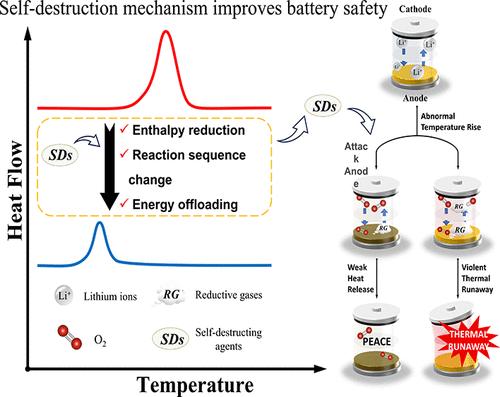Controlled Energy Offloading via Self-Destructing Agents for Safer Li-Ion Batteries
IF 18.2
1区 材料科学
Q1 CHEMISTRY, PHYSICAL
引用次数: 0
Abstract
Addressing the critical safety challenge of thermal runaway in lithium-ion batteries, we introduce a self-destruction strategy incorporating spatiotemporal electron capture agents. In LiNi0.8Co0.1Mn0.1O2 batteries, 7 of 14 tested agents, notably phloroglucinol, effectively modulated thermal runaway pathways, reducing heat release by up to 65% and reducing the peak temperature of 176.1 °C. Phloroglucinol demonstrated particularly positive performance (70% enthalpy reduction and 72% peak temperature-rise rate reduction). Conversely, lithium iron phosphate batteries required alternative approaches as thermal output increased. By correlating agent properties like water-binding energy and phenyl reactivity with performance, we provide actionable guidelines for designing safer battery chemistries, bridging fundamental research with practical applications to mitigate the safety-energy density dilemma.

基于自毁剂的锂离子电池可控能量卸载研究
为了解决锂离子电池热失控的关键安全挑战,我们引入了一种结合时空电子捕获剂的自毁策略。在LiNi0.8Co0.1Mn0.1O2电池中,14种测试剂中的7种,特别是间苯三酚,有效地调节了热失控途径,减少了高达65%的热量释放,降低了176.1°C的峰值温度。间苯三酚表现出特别积极的性能(70%的焓降低和72%的峰值温升速率降低)。相反,随着热输出的增加,磷酸铁锂电池需要替代方法。通过将水结合能和苯基反应性等性能与性能相关联,我们为设计更安全的电池化学物质提供了可操作的指导方针,将基础研究与实际应用联系起来,以缓解安全-能量密度困境。
本文章由计算机程序翻译,如有差异,请以英文原文为准。
求助全文
约1分钟内获得全文
求助全文
来源期刊

ACS Energy Letters
Energy-Renewable Energy, Sustainability and the Environment
CiteScore
31.20
自引率
5.00%
发文量
469
审稿时长
1 months
期刊介绍:
ACS Energy Letters is a monthly journal that publishes papers reporting new scientific advances in energy research. The journal focuses on topics that are of interest to scientists working in the fundamental and applied sciences. Rapid publication is a central criterion for acceptance, and the journal is known for its quick publication times, with an average of 4-6 weeks from submission to web publication in As Soon As Publishable format.
ACS Energy Letters is ranked as the number one journal in the Web of Science Electrochemistry category. It also ranks within the top 10 journals for Physical Chemistry, Energy & Fuels, and Nanoscience & Nanotechnology.
The journal offers several types of articles, including Letters, Energy Express, Perspectives, Reviews, Editorials, Viewpoints and Energy Focus. Additionally, authors have the option to submit videos that summarize or support the information presented in a Perspective or Review article, which can be highlighted on the journal's website. ACS Energy Letters is abstracted and indexed in Chemical Abstracts Service/SciFinder, EBSCO-summon, PubMed, Web of Science, Scopus and Portico.
 求助内容:
求助内容: 应助结果提醒方式:
应助结果提醒方式:


